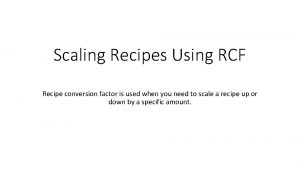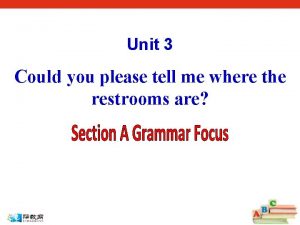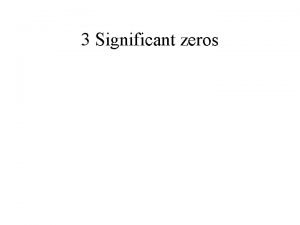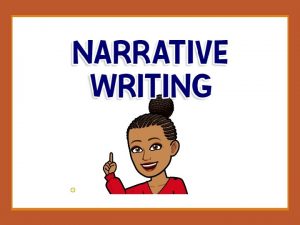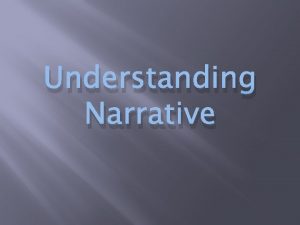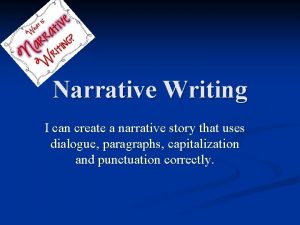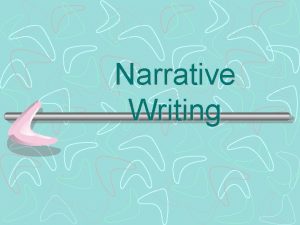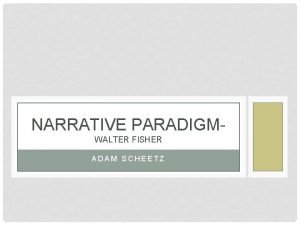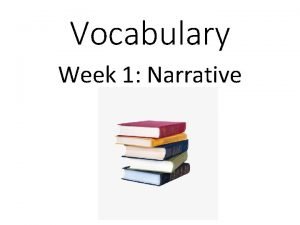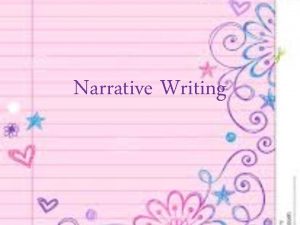Narrative Can you tell a story Recipe for













- Slides: 13

Narrative Can you tell a story?

Recipe for a narrative ¢ The plot is the main ingredient in any story. It refers to all the events that move a story along from start to finish. l A plot has 5 basic parts: 1. 2. 3. 4. 5. introduction rising action climax falling action resolution


1. Introduction ¢ The beginning part of the story. It introduces readers to the main characters and explains when and where the story takes place (setting).

2. Rising Action ¢ The main part of the story during which the main character strives to overcome a problem. (Conflict)

3. Climax ¢ The most intense and exciting point of a story. It makes clear the outcome of events (tells us how the conflict is resolved).

4. Falling Action Tells the reader what the main character does after the climax. It signals to the reader that the story is coming to an end. ¢ This part of the story sometimes reveals the main character’s feelings about what has happened. ¢

5. Resolution ¢ Brings the story to a natural, thoughtprovoking, or surprising end.

Many narratives have the following two features: 1. They are usually written in chronological sequence. • 2. The events or series of events are described in the order in which they happen. They contain vivid details. • Writers want the events they are describing to seem real, so they include details to let you “see” what is happening. Details should also describe the setting and the characters. *Characters in a narrative often speak using dialogue.

To summarize, the narrative: is told from a particular point of view ¢ makes and supports a point ¢ is filled with precise detail ¢ uses vivid verbs and modifiers ¢ uses conflict and sequence as does any story ¢ may use dialogue ¢

Activity: Now you can write a narrative! ¢ Write a one paragraph narrative about one of the following topics: The first day of high school. l The scariest moment of your life. l • • Remember to include all of the elements of a narrative. Rough Copy Due: Wed, February 13 th

Read the beginning of this story: ¢ It was a hot summer day. My dad and I were getting ready to go out for a ride on the boat with my friend Katie and the dog. That’s when the phone call came, the call that made that bright, beautiful day a cold, dark, gloomy one. I had just put on my suit, shorts, and tank top, and packed my bag with sunscreen and everything else I would need for the day. I ran into my parents’ room to find Dad. When I saw him on the phone, he was crying. I’d never seen my dad cry before. My heart sank. I knew exactly what had happened. What happens next? Write the next paragraph which should identify the conflict, the rising action, and the climax.

Swap paragraphs ¢ Have the writer read their paragraph, then you will write the falling action and the resolution in the third paragraph.
 Tell me what you eat and i shall tell you what you are
Tell me what you eat and i shall tell you what you are Kinds of comparison
Kinds of comparison You can tell harris about it just ____(easily) as i can
You can tell harris about it just ____(easily) as i can Positive comparative superlative
Positive comparative superlative If you think you can you can poem
If you think you can you can poem If you can imagine it you can achieve it
If you can imagine it you can achieve it What you don't measure quote
What you don't measure quote If you cannot measure it you cannot manage it
If you cannot measure it you cannot manage it If you cant measure it you can't manage it
If you cant measure it you can't manage it Vertikale bilanzkennzahlen
Vertikale bilanzkennzahlen Recipe conversion factor
Recipe conversion factor Could you tell me where
Could you tell me where Tell me what you really like
Tell me what you really like How can you tell whether zeros are significant
How can you tell whether zeros are significant










